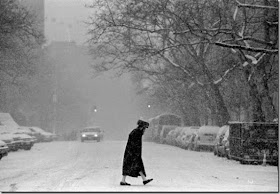Boogie was born Vladimir Milivojevich in
Belgrade, the capital of what was then Yugoslavia. His friends gave him his
nickname because he reminded them of a cartoon character called the Boogieman.
He recalls the Belgrade of his childhood as a peaceful place, where crime rates
were among the lowest in Europe and a strong sense of community prevailed.
This sense of stability changed drastically during the 1990s, he said, as Yugoslavia was upended and Belgrade transformed into a violent and poverty-ridden city. The situation was so drastic that Boogie remembers a period where his mother’s entire monthly pension could only buy two pounds of onions. Bleakness and hopelessness permeated the city. A few of his childhood friends succumbed to heroin addiction. People ended their own lives to avoid dying of starvation. Boogie walked around with homemade dog food to feed abandoned pets. To support his family, he traveled to Bulgaria to smuggle paint and sell it on the black market. (His father painted religious icons, so he knew which paints and colours were in demand.)
His father was also an amateur photographer. He gave Boogie his first camera. Boogie walked the streets day and night, recording the degradation of his city.
“All the moral values in our society somehow disappeared or got twisted during that time,” he said. “I realized much later that I probably started shooting to preserve my sanity, to distance myself from the chaos around me.”
He developed and nurtured a style. He was never influenced by other photographers’ work. He could barely afford film, let alone expensive photo books. He now sees this as an advantage. He was not tempted to emulate anyone else. Instead, he was able to focus solely on creating his own raw aesthetic, which grew organically from his connection to the streets.
In 1997, Boogie and his friends decided on a whim to apply for the United States green card lottery. He had never planned to leave Serbia but it turned out he was the only one of his friends to win. He left Serbia a week before the war in Kosovo began.
In America, he continued to photograph incessantly on the streets, now focusing on the neighborhoods of Bushwick, Bedford-Stuyvesant and Queensbridge. His pictures of heroin addicts and gang members are poignant and shocking.
[via New York Times ]
This sense of stability changed drastically during the 1990s, he said, as Yugoslavia was upended and Belgrade transformed into a violent and poverty-ridden city. The situation was so drastic that Boogie remembers a period where his mother’s entire monthly pension could only buy two pounds of onions. Bleakness and hopelessness permeated the city. A few of his childhood friends succumbed to heroin addiction. People ended their own lives to avoid dying of starvation. Boogie walked around with homemade dog food to feed abandoned pets. To support his family, he traveled to Bulgaria to smuggle paint and sell it on the black market. (His father painted religious icons, so he knew which paints and colours were in demand.)
His father was also an amateur photographer. He gave Boogie his first camera. Boogie walked the streets day and night, recording the degradation of his city.
“All the moral values in our society somehow disappeared or got twisted during that time,” he said. “I realized much later that I probably started shooting to preserve my sanity, to distance myself from the chaos around me.”
He developed and nurtured a style. He was never influenced by other photographers’ work. He could barely afford film, let alone expensive photo books. He now sees this as an advantage. He was not tempted to emulate anyone else. Instead, he was able to focus solely on creating his own raw aesthetic, which grew organically from his connection to the streets.
In 1997, Boogie and his friends decided on a whim to apply for the United States green card lottery. He had never planned to leave Serbia but it turned out he was the only one of his friends to win. He left Serbia a week before the war in Kosovo began.
In America, he continued to photograph incessantly on the streets, now focusing on the neighborhoods of Bushwick, Bedford-Stuyvesant and Queensbridge. His pictures of heroin addicts and gang members are poignant and shocking.
[via New York Times ]
Boogie è il soprannome di Vladimir Milivojevich nato a
Belgrado, la capitale di quello che un tempo era la Jugoslavia. I suoi amici
gli ha dato questo soprannome perché ricordava un personaggio dei fumetti
chiamato Boogieman. Egli ricorda la Belgrado della sua infanzia come un luogo
tranquillo, dove i tassi di criminalità sono stati tra i più bassi in Europa e
dove prevaleva un forte senso di comunità. Questo senso di stabilità è cambiato
drasticamente nel corso degli anni 90, ha detto, mentre la Jugoslavia è stata
messa sottosopra e Belgrado trasformata in una città violenta e degradata dalla
povertà. La situazione è stata così difficile che Boogie ricorda un periodo in
cui con tutta la pensione mensile di sua madre non si poteva comprare due chili
di cipolle. Desolazione e disperazione hanno permeato la città. Alcuni dei suoi
amici d’infanzia hanno ceduto alla dipendenza da eroina. La gente terminò la
propria vita piuttosto che morire di fame. Boogie andava in giro con cibo per
cani fatto in casa per nutrire gli animali domestici abbandonati. Per sostenere
la sua famiglia, si recò in Bulgaria per contrabbandare vernice e venderla sul
mercato nero. Suo padre era anche un fotografo dilettante. Ha dato Boogie sua
prima macchina fotografica. Boogie ha camminato giorno e notte per le strade,
fotografando il degrado della sua città. > sandroesposito
© Vladimir Milivojevich

,+2011,+Belgrade.jpg)
,+undated,+Srdjan,+Wet+Plate+Demons.jpg)


















Nessun commento:
Posta un commento